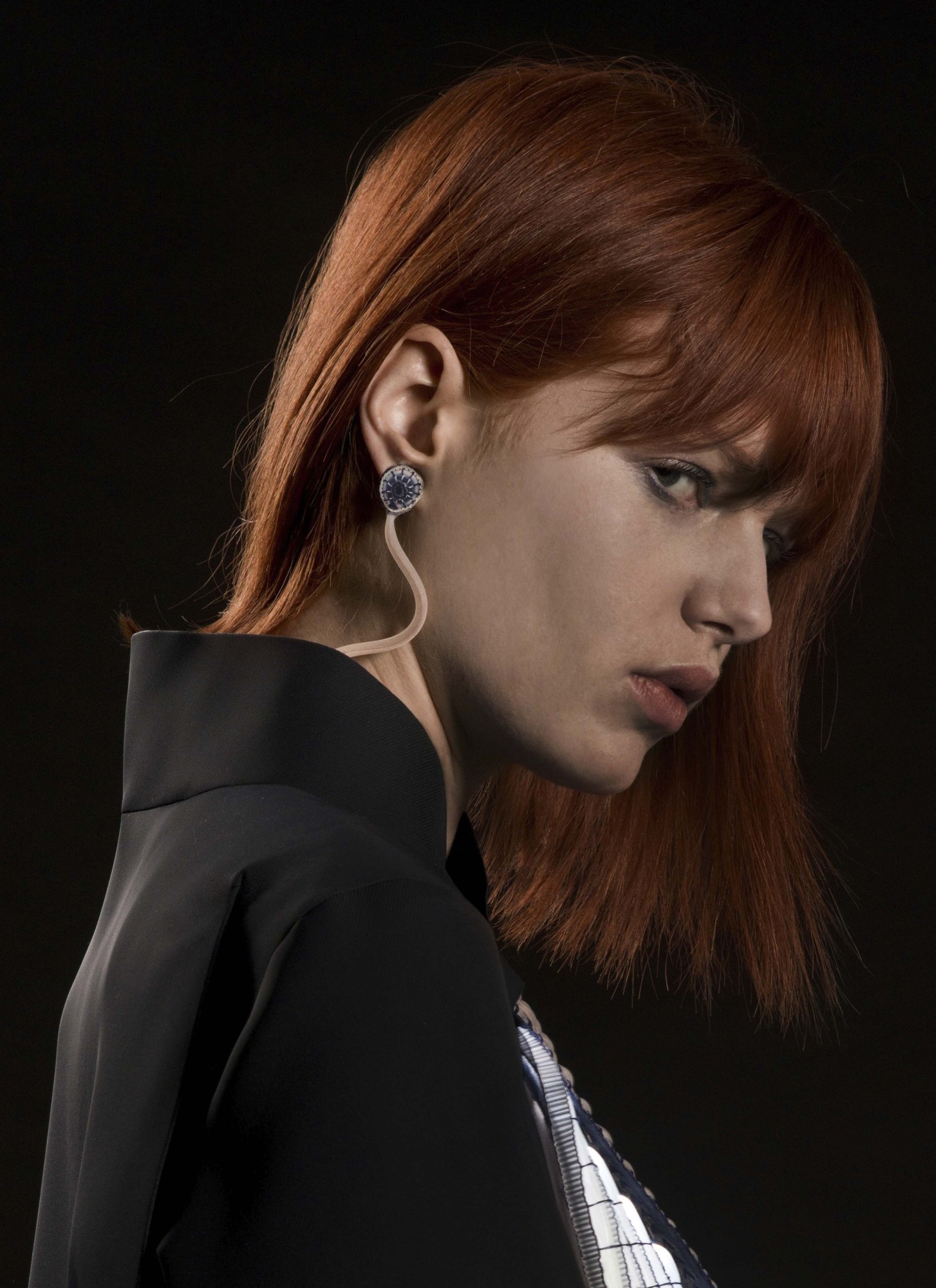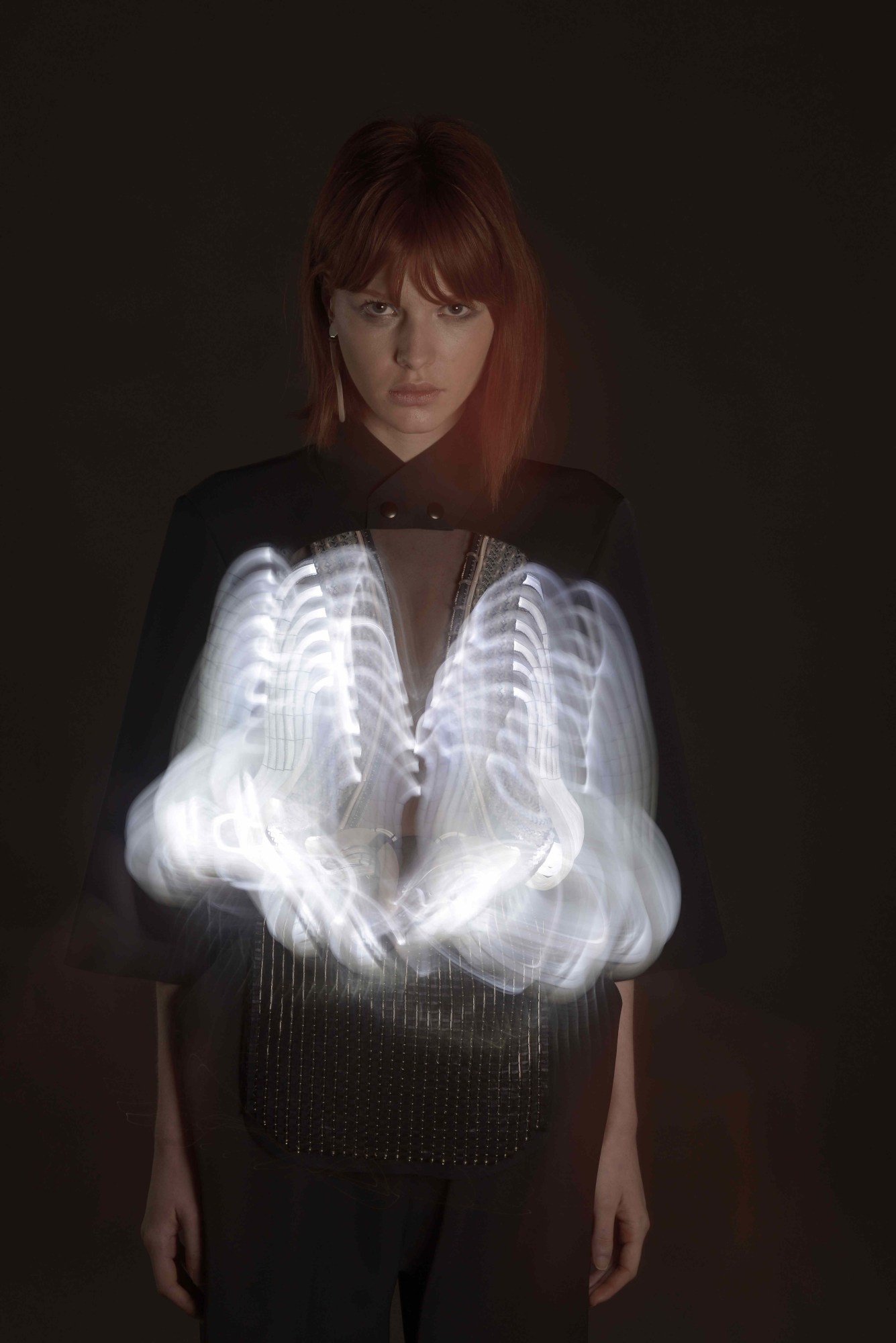“I like experimenting with materials; I like making things with my hands,” says Clara Daguin. The Franco-American designer entwines textiles and tubes, uses conductive thread for couture embroidery, and employs technologies, like a heartbeat sensor, in intricately constructed garments. Having studied graphic design in San Francisco, Daguin transitioned into a masters in fashion at the École Supérieure Des Arts Décoratifs in Paris. She has done stints at Maison Martin Margiela, Hussein Chalayan, and Iris Van Herpen, and this spring was one of ten finalists at Hyères’ Festival International De Mode. She is currently assisting the iconic French polymath Jean-Paul Goude on an upcoming project, and was recently approached by Conchita Wurst’s stylist for her idiosyncratic light-up jumpsuit.
Daguin translates technology into fashion using artful and innovative silhouettes. Tech is present in an impactful but streamlined manner; her garments honor the body even as it goes android. In an industry that’s still mostly wary of technology (Apple watch or bust!), Daguin’s approach is a thoughtful one in a still-nascent arena of design. Here, she discusses her reappropriation of menswear, her attraction to experimentation, and the advantages of remaining low-tech.
Would you describe your aesthetic as feminine?
I think it’s quite feminine. If you look at the pants or the skirts, they take on the hips in a certain way that wouldn’t look right on a man. A lot of my embroideries have this organic roundness, which is feminine. People have asked me if I would do menswear, and if I did, I think I would have to do more geometric embroideries.
Which female designers in the industry inspired your aesthetic and/or your work ethic?
I like Iris Van Herpen. Her stuff is super experimental. There’s a lot of handwork, minute detailing, new techniques, and materials that are kind of weird. And she’s dedicated everything that she has to her line. She’s admirable in that way.

What about women outside the industry who inspired you?
Both of my grandmas were into sewing. My French grandma was a seamstress. My Polish grandma had to sew clothes for her whole family; there was nothing in stores to buy during the Communist era. I don’t know that she was doing it out of creative necessity, or if it was just that her kids wanted bellbottoms. Maybe a bit of both.
Are you interested in making menswear?
The only reason I didn’t include men’s clothes at Hyères is because you had to pick between womenswear or menswear for your collection. I chose womenswear because I know my body, and I haven’t made men’s clothes before. But I would like to explore that. All of the clothes that I made, I took from menswear. Every piece is actually based off an old men’s jacket or pants, and put on a woman’s body and collaged into a new shape. I’m more inspired by men’s clothes, because they’re simpler; there’s no bullshit. You can find a lot of interesting details and shapes: if you take a huge men’s jacket and put it on a girl, it’s going to fall differently, and that’s interesting. I’m re-appropriating menswear but changing it around, not just having women wear men’s clothes. Which is what I do. [Tugs at her shirt] This is my boyfriend’s top!
The tech is obviously a visual and material choice, but does it have a more symbolic connotation, of appropriating this male-saturated realm for the female body?
I think tech is something anyone can master. But the way I use technology… I prefer for it to be beautiful in the end. I’m interested in le vêtement; I’m not interested in t-shirts with LEDs in them.
I use simple stuff; I’m not like a geek, in the sense that I want my pieces to have all these functions. That’s not what I think is interesting. What I like to do is just use the simplest — the minimum — amount of tech for the clothes to be heightened and more interesting. It’s about the clothes first.

What do you think the potential is for technology in fashion, in a way that’s not geeky or heavy-handed? The fashion industry seems quite reticent about it.
What’s been presented so far, for the most part, is something that is really high-tech, where there’s a lot of technology and not enough fashion. It’s not fashion that people want to wear. If you have technology embedded into something that’s already itself tech-y, it doesn’t take it anywhere. There is a small percentage of people who think it’s cool, but then you’re not addressing the people who are in fashion, and who don’t give a shit about technology. To reach them, you have to make it look nice, and wearable.
For people who are tech-savvy, my stuff is so basic. It’s LEDs and sometimes a microprocessor. It could be so much more. But for this collection, more wasn’t necessary.
If you had the resources, would high-tech be appealing?
To express something else, it could be interesting to integrate other things. But then you have to collaborate with people who are extremely tech savvy, to get all the information. Otherwise, I’d have to research every time I wanted to do something new, and that takes a lot more development.
Are there sites you consult to see what’s happening in the tech world?
There’s one girl who’s really cool: Hanna Perner Wilson. Her website is called How to Get What You Want. She only does experiments. She knits with conductive thread, for example. Her interest is in soft electronics: fabric, or integrating circuits using conductive thread instead of electrical thread. The way she does it, you can feel there’s something feminine about it. Everything’s explained really nicely, you have materials’ lists, and where to buy stuff, and she always rates what’s better. I’ve used her experiments to make a finished product. I sometimes experiment too, but it’s not technical experimentation; it’s visual. For my embroidery, for example, I’ll do a bunch of tests to see how it could look, but I’m not testing different techniques very often.

Credits
Text Sarah Moroz
Images courtesy Clara Daguin
Photography Alice Bryglo
Make-up Rousi Li
